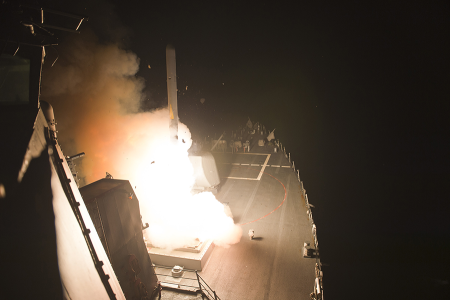"I greatly appreciate your very swift response, and your organization's work in general. It's a terrific source of authoritative information."
U.S. Starts Work on Nuclear-Capable Missile
July/August 2024
By Xiaodon Liang
The Biden administration dropped its opposition to a proposed nuclear-capable, sea-launched cruise missile, also known as SLCM-N, in its response to this year’s House defense policy bill. Officials say work on the missile has begun.

In its June 11 statement of administration policy in response to the House Armed Services Committee’s version of the national defense authorization bill for fiscal year 2025, the Biden administration did not repeat its previous years’ opposition to the missile. When asked for comment, a U.S. official told Arms Control Today that last year’s defense bill “directed” the Defense Department and the National Nuclear Security Administration “to establish and commence implementation” of a nuclear-capable, sea-launched cruise missile program.
“We will comply with the [bill] requirement and will look to execute in a manner that provides the most deterrence value for the least risk to the modernization program, the production enterprise, and other defense priorities,” the official said.
In fiscal year 2024, Congress appropriated $90 million for the missile and $70 million for work on its warhead. It also instructed the Defense Department to establish a development program for the missile. The House bill for 2025 would raise the missile’s annual budget to $190 million and maintain warhead funding at $70 million.
Last year’s statement of administration policy said the president “strongly opposes” the missile and that it “has marginal utility.” The statement also said “deploying [the missile] on Navy attack submarines or surface combatants would reduce capacity for conventional strike munitions [and] create additional burdens on naval training, maintenance, and operations.”
Sen. Mark Kelly (D-Ariz.) raised these issues during a May 24 hearing of the Senate Armed Services strategic forces subcommittee. “One of my biggest concerns is that we would be giving up something we really need for something we are unlikely to use,” Kelly said, referring to the possibility that the missile would displace conventional munitions aboard Navy attack submarines.
In response, Vice Adm. Johnny R. Wolfe Jr., the Navy’s director for strategic systems programs, acknowledged that “yes, there will be some impact” to the nuclear-powered attack submarine force.
“Anytime you have a conventional mission with a nuclear mission, you have to be very careful to segregate those and make sure that our war-fighters understand how that operates,” he said. Wolfe said the Navy is analyzing how to minimize the impact of fielding the missile.
In his prepared remarks, Wolfe also hinted at the resource constraints that would affect the program. “Executing this program successfully will require careful balancing of [missile] programmatic manning with ongoing Navy programs, which draw from a limited pool of experienced government personnel and the same nuclear weapons industrial base,” he said.
Testifying at an April 30 hearing before the House Armed Services strategic forces subcommittee, Bill LaPlante, undersecretary of defense for acquisition and sustainment, said that the Navy has set up an office to manage the missile program and that it aims to clear its first programmatic hurdle, known as Milestone A, within a year. Before passing Milestone A, program officials must produce documents justifying the need for the missile, conduct an analysis of alternatives, and provide an initial cost estimate.
The Navy said on June 14 it likely would award the first contract for the missile in July. In a presolicitation notice required under contracting rules, the Navy said it intends to negotiate a sole-source contract with Virginia-based Systems Planning Analysis Inc., covering research and development for up to four years.
